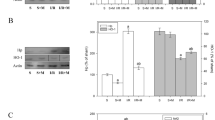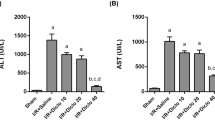Abstract
The protective effect of FK506 on hepatocytes against ischemia and reperfusion injury was examined by evaluating the following: the high energy phosphorus metabolism obtained using 31P magnetic resonance spectroscopy (31P-MRS) and the tissue blood flow of the liver in ischemia and the reperfusion process, mitochondrial glutamic oxaloacetic transaminase (m-GOT) and glutamic pyruvic transaminase (GPT), the survival rates of the animals, a histological study and immunohistological staining for intercellular adhesion molecule-1 (ICAM-1) in the liver after ischemia. The rats were treated with FK506 1 mg/kg/day i.m. for 4 days before testing. Ischemia was induced by clamping the hepatoduodenal ligament for 30 min. In31P-MRS, the recovery of the hepatic energy status after ischemia, evaluated by β-ATP/inorganic phosphate (Pi), was significantly better in the FK506 group. It also coincided with the recovery of tissue blood flow monitored with a laser Doppler flowmeter. In the histological examination, the congestion observed in the periportal region of the control group was mild, while there was less induction of ICAM-1 in the endothelial cells of the portal veins and hepatic veins in the FK506 group. From these findings, we concluded that FK506 had a protective effect on hepatocytes against warm ischemia and reperfusion injury, and the mechanism for this could partially be attributed to improved tissue blood flow after ischemia by the modulation of immunological events.
Similar content being viewed by others
References
Wakabayashi H, Karasawa Y, Maeba T, Tanaka S (1992) Effect of FK506 and cyclosporine A on hepatic energy status in the rat after warm ischemia, as monitored by31P nuclear magnetic résonance spectroscopy in vivo. Transplant Proc 24:1993–1995
Dhar DK, Nagasue N, Kimoto T, Uchida M, Takemoto Y, Nakamura T (1992) The salutary effect of FK506 in ischemiareperfusion injury of the canine liver. Transplantation 54:583–588
Francavilla A, Barone M, Todo S, Zeng Q, Porter KA, Starzl TE (1989) Augmentation of rat liver regeneration by FK506 compared with cyclosporine. Lancet 25:1248–1249
Starzl TE, Porter KA, Mazzaferro V, Todo S, Fung J, Francavilla A (1991) Hepatotropic effects of FK506 in dogs. Transplantation 51:67–70
Mazzaferro V, Scotti-Foglieni CL, Porter KA, Trejo-Bellido J, Carrieri G, Todo S, Fung JJ, Francavilla A, Starzl TE (1990) Studies of hepatotropic qualities of FK506 and CyA. Transplant Proc 22:93–95
Sakr MF, Zetti GM, Farghali H, Hassanein TH, Gavaler JS, Starzl TE, Van Thiel DH (1991) Protective effect of FK506 against hepatic ischemia in rats. Transplant Proc 23:340–341
Sakr MF, Zetti GM, Hassanein TI, Farghali H, Nalesnik MA, Gavaler JS, Starzl TE, Van Thiel DH (1991) FK506 ameliorates the hepatic injury associated with ischemia and reperfusion in rats. Hepatology 13:947–951
Starzl TE, Todo S, Fung J, Demetris AJ, Venkataramman R, Jain A (1989) FK506 for liver, kidney, and pancreas transplantation. Lancet 2:1000–1004
Bore PJ, Paratheofanis I, Sells RA (1979) Adenosine triphosphate regeneration and function in the rat kidney following warm ischemia. Transplantatoin 27:235–237
Marubayashi S, Takenaka M, K Dohi, Ezaki H, Kawasaki T (1980) Adenine nucleotide metabolism during hepatic ischemia and subsequent blood reflow periods and its relation to organ viability. Transplantation 30:294–296
Cohen SM (1983) Application of nuclear magnetic resonance to the study of liver physiology and disease. Hepatology 3:738–749
Granger DN, Rutili G, Maccord JM (1981) Superoxide radicals in feline intestinal ischemia. Gastroenterology 81:22–29
Kawano K, Kim Y, Goto S, Ono M, Kobayashi M (1991) A protective effect of FK506 in ischemically injured rat liver. Transplantation 52:143–145
Hernandez LA, Grisham MB, Twohig B, Arfors KE, Marlan JM, Granger DN (1987) Role of neutrophils in ischemiareperfusion-induced microvascular injury. Am J Physiol 253:H699–703
Grisham MB, Hernandez LA, Granger DN (1986) Xanthine oxidase and neutrophil infiltration in intestinal ischemia. Am J Physiol 251:G567–574
Dustin ML, Rothlein R, Bhan AK, Dinarello CA, Springer TA (1986) Induction by IL-1 and interferon-gamma: tissue distribution, biochemistry, and function of a natural adherence molecule (ICAM-1). J Immunol 137:245–254
Korthuis RJ, Grisham MB, Granger DN (1988) Leukocyte depletion attenuates vascular injury in postischemic skeletal muscle. Am J Physiol 254:H823
Engler RL, Dahlgre MD, Morris DD, Peterson MA, Schmid-Schönbein GW (1986) Role of leukocytes in response to acute myocardial ischemia and reflow in dogs. Am J Physiol 251:H314–322
Granger DN, Benoit JN, Suzuki M, Grisham MB (1989) Leukocyte adherence to venular endothelium during ischemia. Am J Physiol 257:G683–688
Marzi I, Knee J, Bühren V, Menger M, Trentz O (1992) Reduction by superoxide dismutase of leukocyte-endothelial adherence after liver transplantation. Surgery 111:90–97
Schmid-Schönbein GW (1987) Capillary plugging by granulocytes and the no reflow phenomenon in the microcirculation. Federation Proc 46:2397–2401
Hoffmann MW, Wonigeit K, Steinhoff G, Herzbeck H, Flad HD, Pichlmayr R (1993) Production of cytokines (TNF-alpha, IL-1-beta) and endothelial cell activation in human liver allograft rejection. Transplantation 55:329–335
Geng JG, Bevilacqua MP, Moore KL, McIntyre TM, Prescott SM, Kim JM, Bliss GA, Zimmerman GA, McEver RP (1990) Rapid neutrophil adhesion to activated endothelium mediated by GMP-140. Nature 343:757–760
Viebahn R, de Groot H, Lauchart W, Becker HD (1991) Hypoxic and reoxygenation injury in human and rat hepatocytes Influence of FK506 and cyclosporine. Transplant Proc 23:3183–3184.
Pelekanou V, Trezise AE, Moore AL, Kay JE (1991) FK506 and Rapamycin do not affect platelet aggregation or mitochondrial function. Transplant Proc 23:3200–3201
Author information
Authors and Affiliations
Rights and permissions
About this article
Cite this article
Wakabayashi, H., Karasawa, Y., Tanaka, S. et al. The effect of FK506 on Warm Ischemia and reperfusion Injury in the Rat Liver. Surg Today 24, 994–1002 (1994). https://doi.org/10.1007/BF02215813
Received:
Accepted:
Issue Date:
DOI: https://doi.org/10.1007/BF02215813




